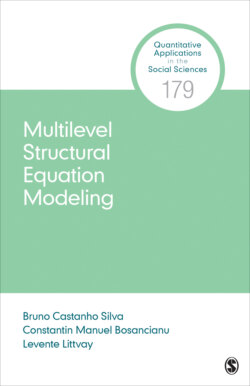Читать книгу Multilevel Structural Equation Modeling - Bruno Castanho Silva - Страница 7
На сайте Литреса книга снята с продажи.
Series Editor’s Introduction
ОглавлениеI am pleased to introduce Multilevel Structural Equation Modeling, by Bruno Castanho Silva, Constantin Manuel Cosancianu, and Levente Littvay. Multilevel structural equation models (MSEMs) combine the study of relationships between variables measured with error central to structural equation modeling (SEM) with an interest in macro-micro relationships central to multilevel models (MLM). This volume is well-organized with a clear progression of topics, starting with SEMs of observed variables, proceeding to confirmatory factor analysis (CFA), and then the full model, adding a multilevel component to each along the way. In each chapter, the authors proceed systematically from simpler to more complex model specifications, using examples to illustrate each step. Readers can practice by replicating these examples using materials available in the online appendix.
An innovation of the volume is the notation. SEMs and MLMs each have their own conventions; the authors blend them. They maintain notation used in standard multilevel texts but introduce superscripts to keep track of the outcome variable associated with particular coefficients. This approach makes it possible to write MSEM models as a series of equations, making the volume broadly accessible, even to readers not well-versed in matrix algebra. To further reinforce the reader understanding, they show most models both as a set of equations and also as graphical presentations that build on SEM traditions.
In terms of the preparation needed, readers having experience with structural equations models (SEM) or multilevel models (MLM) are in the best position to benefit from this volume. Chapter 1 provides a very helpful review of both, and then shows how the model and notation can be organized into a single framework for MSEM. Chapter 2 introduces multilevel path models, considering both the random intercept model and the random slopes model. It uses World Values Survey data, Wave 4, from 55 countries to explore the individual-level and country-level factors associated with high self-expression values (importance of civic activism, subjective well-being, tolerance and trust, personal autonomy and choice). Multilevel factor models are the focus of Chapter 3. This chapter uses data from the 2015 wave of the Program for International Student Assessment (PISA) on the use of digital devices in the Dominican Republic to build a two-level CFA, starting with a comparison of the multilevel CFA to the multiple group CFA, then building in random latent variable intercepts and finishing with a multilevel CFA with random loadings. It also includes a useful discussion of measurement invariance. Chapter 4 merges the subject matter of chapters 2 and 3 together into the full multilevel structural equation model (MSEM). The example for this chapter, based on the 2004 Workplace Employment Relations Survey teaching dataset, explores whether employees consider themselves to be under- or over-qualified for their jobs, as affected by their perception of how demanding their jobs are, how responsive their managers, their pay, and—at the company level—number of employees. Chapter 5 concludes the text by addressing some advanced topics such as categorical dependent variables, sampling weights, and missing data, pointing to references where the interested reader can learn more and providing advice on how to approach the technical literature.
Multilevel structural equation models can be quite complex. Indeed, as the authors say, the complexity of the models to be investigated is only limited by the imagination of the investigators (and of course, the data, software, etc.). Given this, readers will especially appreciate this hands-on introduction and the lengths to which the authors have gone to make the material accessible to researchers from a variety of backgrounds.
—Barbara Entwisle
Series Editor
